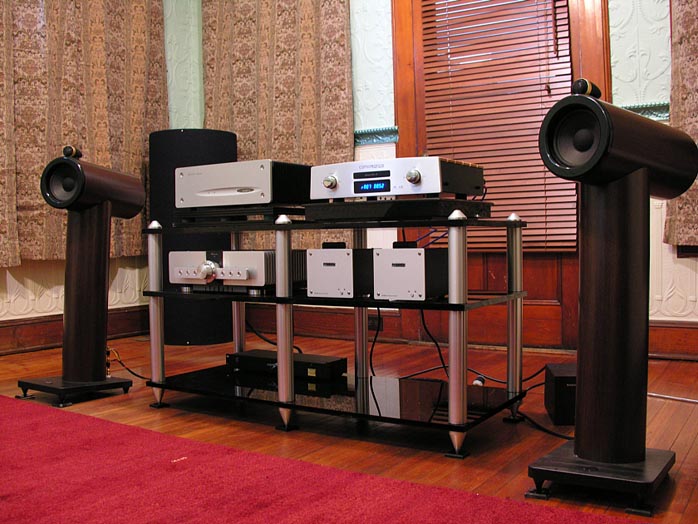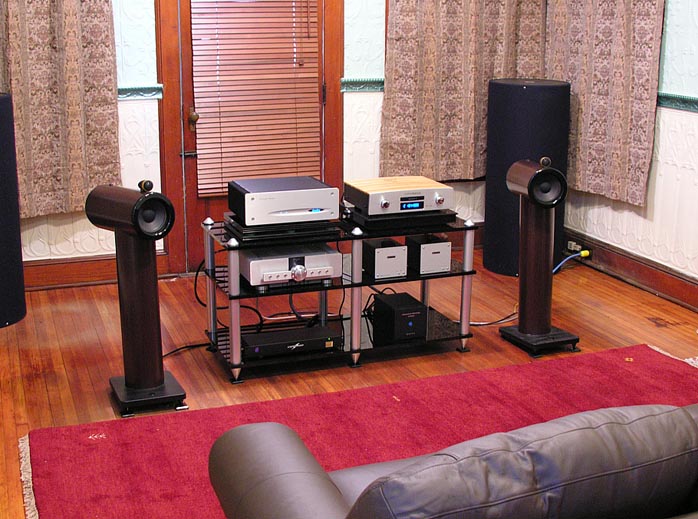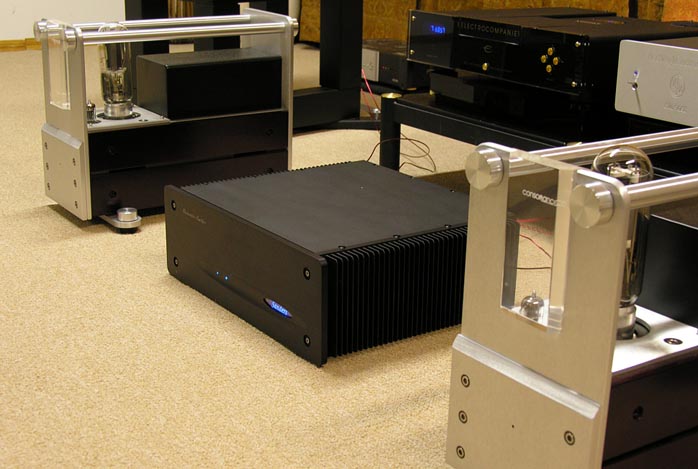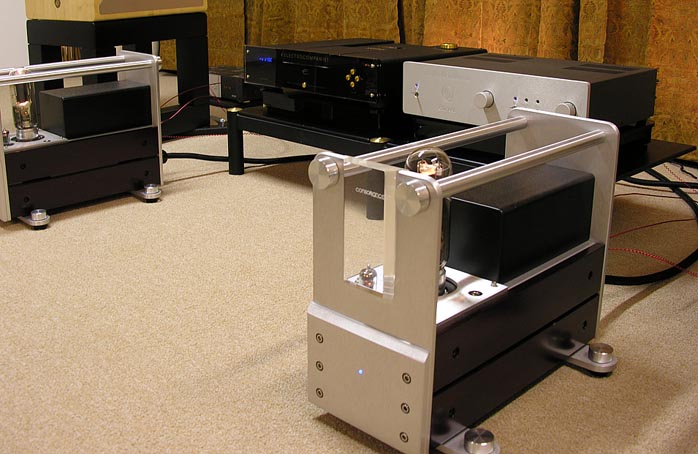 |
|||||||
| I guess I never realized it like this before. When you walk into an audio store and start perusing the inventory, you're certainly going to be seeing variations on a theme - but it's just one theme. The products assembled in that store represent different roads but they all go to basically the same place; a sound that reflects the owner's idea of what represents good sound. He'll carry tubes and solid-state and he'll carry different brands of speakers and you'll hear products that you'll like better than others but in the big scheme of things, they will all sound more similar than not. At first glance a big inventory may lead you to believe you're presented with some real choices but in the end, this may not really be so. |
|||||||
 |
|||||||
Never before was this brought home to me with real appreciation until I drove three hours to pay a visit to Vinh Vu and Norman Ginsburg and checked out their Norvinz way of doing business. In one afternoon I heard three different systems in three different settings with three vastly diverse sonic signatures; three vastly different and very personal takes on what represents good sound reproduction. Three personal takes because a Norvinz FR (field rep) is free to pick and choose and assemble a system that reflects his priorities, whether or not he's able to offer all of the components for sale. He has assembled a system that represents his interpretation of good sound - a system that he believes in, not just a system that he's trying to sell you on. And now he's able to demonstrate how the individual parts of that system contribute to what you're hearing. I had my favorite and you would too but more importantly, you'd have gotten three very different options, three distinct targets toward which you may have wanted to orient your purchasing decisions. Or maybe you'd even want to aim between any two of these points in hopes of achieving your own unique version of perfection. |
|||||||
 |
|||||||
My first stop was at Vinh Vu's home to hear a system assembled, presumably, to meet his version of musical satisfaction. Vinh was spinning vinyl on the Merrill-Scillia Research MS21 turntable with the Tri-Planar tone arm, a ZYX Airy 3 cartridge and Sutherland PhD phono preamp. CDs were spinning within the Copeland 823 transport feeding a Kora Hermes DAC. Source switching and volume control were handled by the Channel Island Audio PLC-1 remote controlled passive preamp which fed a pair of Opera Audio Cyber 300BPSE. In turn, these 300B amps were pushing and pulling on a pair of RL Acousique Lamhorn 1.8 loudspeakers fitted with AER drivers. The system was strung together with Luminous Audio Synchestra Reference interconnects and Gingko Audio Cantare speaker wires. |
|||||||
 |
|||||||
If the retrieval of detail reins paramount in your veins and vision, this may be your system. It produced a sound that was big, airy and ethereal with gobs of musically significant detail. There was no spotlighting per se and while the system had satisfying bass and plenty of subjective treble extension, this system was a midrange lover's dream. The antithesis of clinical, this system produced details for the sake of allowing the listener further into the music. Light on its feet, this system floated like a butterfly but stung like a bee using microdynamic finesse for its attacks. I was pleased to hear that the AER equipped Lamhorn 1.8 loudspeakers, while lively and exciting, exhibited none of the peaky upper midrange prominence of an unmodified Lowther driver. Of particular note was how this system did vocals - just wonderful. |
|||||||
 |
|||||||
For Vu's take on what can be accomplished within greater budgetary constraints, we took a bit of a drive into town. Vu actually shares that space within a small building and occupies the back room. Small building, two rooms - low overhead. No walk-in traffic either since there's no sign out front. Vu's room probably represents a slightly larger than average living room in total volume. Remember, he doesn't want to replicate the typical showroom demonstration. He wants the listener to get a feeling for how these components will sound in a living room. Acoustic treatment is minimal, you may not even see the tube traps I did. Vinh's still evaluating them. On display were Vu's own Tubulous speakers being juiced by a Sanders ESL solid-state amplifier. Source was Opera Audio's Consonance Ref. 2.0 SACD player. No analog system here and no preamp either; volume control was done remotely from the SACD player. Interconnects were by Anti-Cables and speaker wires were the Cantare from Gingko Audio. |
|||||||
 |
|||||||
Light, airy and midrange-centric like the first system? Not at all. This system was a brother from a very different mother. It traded off some of that enlightened midrange sophistication for a punchy sound with dense images and a more pronounced presence of both bass and treble. Imaging and focus were very good and this system produced gobs of depth. It represented a well-done yet cost-constrained approach to the kind of sound most people are most familiar with. The next stop on my trip opened my eyes and ears to yet another and again completely different kind of presentation as we headed toward Field Rep Adrian's home. |
|||||||
 |
|||||||
If you hate salesmen, you'll love Adrian. He'll probably make one poor salesman, being just too sincere and laid back. Let's hope so anyway. Adrian holds a PhD and works in chemical research. He's one heady guy with varied hobbies and musical tastes. His wife also makes what is undoubtedly the best Baklava I've ever tasted. Moist and tender with a touch of cinnamon - delicious. Don't hold your breath though; membership of the audio press obviously has its privileges. On display in Adrian's listening room was his pair of Escalante Design Fremont loudspeakers and an Electrocompaniet EMC 1 CD player. Remote-controlled preamplification duties fell to his ModWright SWL 9.0 tube line stage. For sale, he can demonstrate both the Opera Audio Cyber 211 with 211 tubes from GE or the solid-state Sanders ESL amplifier. Adrian also uses speaker cables and interconnects from Anti-Cables. |
|||||||
 |
|||||||
If you've never seen a pair of the Fremonts in the flesh, they're quite a sight. This stand-mounted two-way measures almost 29 inches high by 14-inches wide and 18 inches deep. It also weighs in at 100 pounds and is perched atop a 90-pound stand. That's not just dense, that's just big. And they sounded even bigger. Their compound woofer configuration utilizes dual 12-inchers and that means two things; much more bass than you'd predict yet each woofer operates with limited excursion so it can also do the midrange thing. The downside to compound woofers is usually being bear to drive and requiring copious amounts of current. I was shocked to hear how well the Opera Cyber 211s' 16 watts per channel worked on the Escalantes. For yet another variation on this very different theme, try the solid-state Sanders amp and see what lights your fire. I'm tempted to say that if you liked the light and ethereal first system, you'd hate this one - or vice-versa. But that's not likely to be true. |
|||||||
 |
|||||||
Truth is, I liked them both for very different reasons. If you don't think that the power and brawn of a full symphony can be recreated in your listening room with a domestically acceptable speaker, check out the Escalantes. We're talking about full-bodied pedal-to-the-metal weight and authority of a symphony as heard four rows back in front of the double basses. I found their rendition of full-scale symphonic music thrilling. Adrian is also into various types of techno and this system can pound it out as no wimpy single-driver speaker I've ever heard - or even imagined. And thus ended my single-day Road Tour. Three different systems, three very different sounds and some real options for the potential buyer. No, I couldn't have purchased most of the components I heard and they couldn't even try to sell them all to me since Norvinz only handles some of them. All of that means less pressure, more listening fun. Such is the beauty of the Norvinz way of doing business and I predict there's more field reps in the wings waiting to be signed on. |
|||||||
 |
|||||||
 |
|||||||
|
Norvinz website
|
|||||||
 |
|||||||